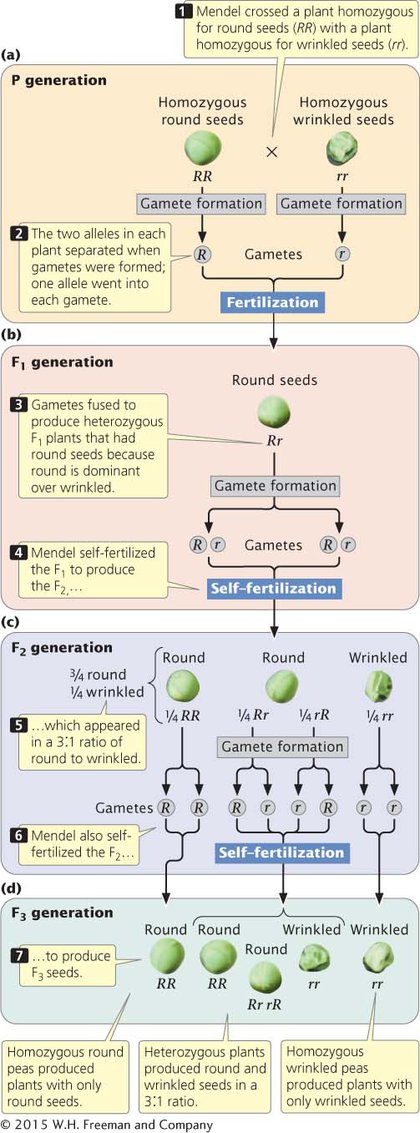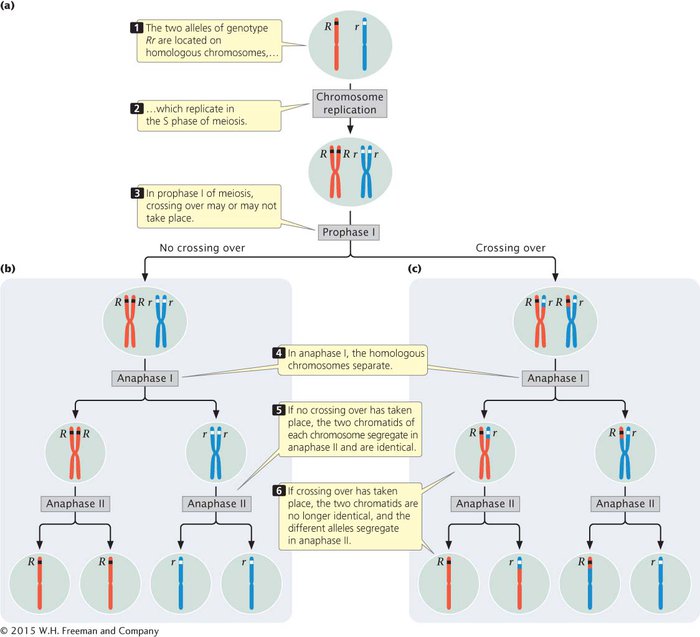What Monohybrid Crosses Reveal
Mendel drew several important conclusions from the results of his monohybrid crosses. First, he reasoned that, although the F1 plants display the phenotype of only one parent, they must inherit genetic factors from both parents because they transmit both phenotypes to the F2 generation. The presence of both round and wrinkled seeds in the F2 plants could be explained only if the F1 plants possessed both round and wrinkled genetic factors that they had inherited from the P generation. He concluded that each plant must therefore possess two genetic factors encoding a characteristic.
The genetic factors (now called alleles) that Mendel discovered are, by convention, designated with letters: the allele for round seeds is usually represented by R and the allele for wrinkled seeds by r. The plants in the P generation of Mendel’s cross possessed two identical alleles: RR in the round-

The second conclusion that Mendel drew from his monohybrid crosses was that the two alleles in each plant separate when gametes are formed, and one allele goes into each gamete. When two gametes (one from each parent) fuse to produce a zygote, the allele from the male parent unites with the allele from the female parent to produce the genotype of the offspring. Thus, Mendel’s F1 plants inherited an R allele from the round-
Mendel’s fourth conclusion was that the two alleles of an individual plant separate with equal probability into the gametes. When plants of the F1 (with genotype Rr) produced gametes, half of the gametes received the R allele for round seeds and half received the r allele for wrinkled seeds. The gametes then paired randomly to produce the following genotypes in equal proportions among the F2: RR, Rr, rR, rr (Figure 3.4c). Because round (R) is dominant over wrinkled (r), there were three round seeds (RR, Rr, rR) for every one wrinkled seed (rr) in the F2. This 3:1 ratio of round to wrinkled progeny that Mendel observed in the F2 could be obtained only if the two alleles of a genotype separated into the gametes with equal probability.
The conclusions that Mendel developed about inheritance from his monohybrid crosses have been further developed and formalized into the principle of segregation and the concept of dominance. The principle of segregation (Mendel’s first law) states that each individual diploid organism possesses two alleles for any particular characteristic, one inherited from the maternal parent and one from the paternal parent. These two alleles segregate (separate) when gametes are formed, and one allele goes into each gamete. Furthermore, the two alleles segregate into gametes in equal proportions. The concept of dominance states that when two different alleles are present in a genotype, only the trait encoded by one of them—
49
Mendel confirmed these principles by allowing his F2 plants to self-
The plants grown from round seeds—
CONCEPTS
The principle of segregation states that each individual organism possesses two alleles that can encode a characteristic. These alleles segregate when gametes are formed, and one allele goes into each gamete. The concept of dominance states that when the two alleles of a genotype are different, only the trait encoded by one of them—
 CONCEPT CHECK 3
CONCEPT CHECK 3
How did Mendel know that each of his pea plants carried two alleles encoding a characteristic?
The traits encoded by both alleles appeared in the F2 progeny.
50
CONNECTING CONCEPTS
Relating Genetic Crosses to Meiosis
We have now seen how the results of monohybrid crosses are explained by Mendel’s principle of segregation. Many students find that they enjoy working genetic crosses but are frustrated by the abstract nature of the symbols. Perhaps you feel the same at this point. You may be asking, “What do these symbols really represent? What does the genotype RR mean in regard to the biology of the organism?” The answers to these questions lie in relating the abstract symbols of crosses to the structure and behavior of chromosomes, the repositories of genetic information (see Chapter 2).
In 1900, when Mendel’s work was rediscovered and biologists began to apply his principles of heredity, the relation between genes and chromosomes was still unclear. The theory that genes are located on chromosomes (the chromosome theory of heredity) was developed in the early 1900s by Walter Sutton, then a graduate student at Columbia University. Through the careful study of meiosis in insects, Sutton documented the fact that each homologous pair of chromosomes consists of one maternal chromosome and one paternal chromosome. Showing that these pairs segregate independently into gametes in meiosis, he concluded that this process is the biological basis for Mendel’s principles of heredity. German cytologist and embryologist Theodor Boveri came to similar conclusions at about the same time.
The symbols used in genetic crosses, such as R and r, are just shorthand notations for particular sequences of DNA in the chromosomes that encode particular phenotypes. The two alleles of a genotype are found on different but homologous chromosomes. One chromosome of each homologous pair is inherited from the mother and the other is inherited from the father. In the S phase of meiotic interphase, each chromosome replicates, producing two copies of each allele, one on each chromatid (Figure 3.5a). The homologous chromosomes segregate in anaphase I, thereby separating the two different alleles (Figure 3.5b). This chromosome segregation is the basis of the principle of segregation. In anaphase II of meiosis, the two chromatids of each replicated chromosome separate, so each gamete resulting from meiosis carries only a single allele at each locus, as Mendel’s principle of segregation predicts.

51
If crossing over has taken place in prophase I of meiosis, then the two chromatids of each replicated chromosome are no longer identical, and the segregation of different alleles takes place at anaphase I and anaphase II (Figure 3.5c). However, Mendel didn’t know anything about chromosomes; he formulated his principles of heredity entirely on the basis of the results of the crosses that he carried out. Nevertheless, we should not forget that these principles work because they are based on the behavior of actual chromosomes in meiosis.  TRY PROBLEM 28
TRY PROBLEM 28